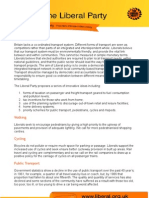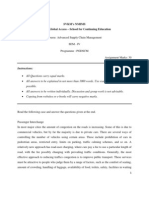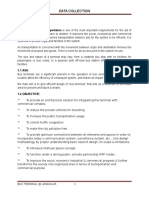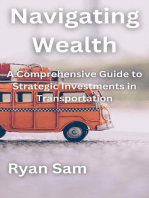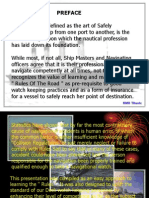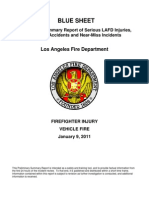Holanda - Notas Varias Transporte
Holanda - Notas Varias Transporte
Uploaded by
jbsandovalCopyright:
Available Formats
Holanda - Notas Varias Transporte
Holanda - Notas Varias Transporte
Uploaded by
jbsandovalCopyright
Available Formats
Share this document
Did you find this document useful?
Is this content inappropriate?
Copyright:
Available Formats
Holanda - Notas Varias Transporte
Holanda - Notas Varias Transporte
Uploaded by
jbsandovalCopyright:
Available Formats
Types of public transport
Public transport in the Netherlands consists of urban transport, regional transport and rail transport.
Bus
The national government wants all buses in public transport to be clean and economical by 2020. The bus networks must also be easily accessible to people with a physical handicap.
Tram
There are trams in Amsterdam, the Hague, Rotterdam and Utrecht. They operate in these large cities because they are suitable for the transportation of large numbers of passengers. A bus is sufficient for fewer passengers.
Underground (Metro)
Of the four large cities in the Netherlands, Amsterdam and Rotterdam have an underground line. The metros operate in a closed system, which does not intersect with normal road traffic. Just as with the bus and the tram, the provinces and urban regions are responsible for the safety of the underground. Moreover, the Inspectorate for Transport, Public Works and Water Management supervises the safety of the metro lines.
Regional taxi
The regional taxi is public transport on demand and provides door-to-door transport. The regional taxis also go to destinations where regular public transport does not. The price of regional taxis lies between public transport and regular taxis.
Light rail
Light rail lies between the train and tram. Light rail travels over longer distances than the tram but more slowly than the train and it stops at more places. Light rail is therefore suitable for regional routes but not for long distances.
Train
The number of passengers using the train is growing. The government wishes to accelerate this growth and increase the number of trains to eventually six intercity trains and six sprinters per hour on the busiest routes. Expansion of the railway network, better travel information and Internet in the train should make the train more attractive as an alternative to the car.
High-speed line South
The high-speed line runs between Schiphol airport and Antwerp. The Dutch part of the line is called the HSL-South. On this route, high-speed trains travel from Amsterdam to the Belgian border.
More efficient freight transport and circulation on motorways
The Netherlands is a transport country and a large part of freight transport is done via the roads. A disadvantage of this is that the roads are therefore becoming ever fuller and traffic jams arise.
The central government has taken a number of measures to promote circulation on the motorways, such as establishing overtaking bans for trucks during peak hours. Furthermore, alongside road transport, the transport sector can also make use of freight transport by water or rail or a combination thereof.
Supply chain management
The central government wants the transport sector to organise freight transport more efficiently. For example, by transportin g goods (partly) by train or by inland navigation vessels. Intelligent combinations of freight transport by road, rail and over the water can also ensure fewer unnecessary truck journeys on the roads.
The government is stimulating supply chain management. In practice, supply chain management concerns everything that has to do with the planning and execution of goods flows.
Measures that should ensure that the transport sector can offer more high-value services around freight transport without overloading the living environment and the road network are focused on energy savings for trucks and sustainable logistics.
Supplying cities and shops
Freight transport is essential for supplying shops in cities and villages. Because freight transport by lorry is usually not a (good) alternative, municipalities and businesses must join forces to make the supply of shops more efficient. This can be done in various ways, for example, by collecting goods on the edge of the city and subsequently taking them to the shops in a single lorry. Thus, the suppliers do not need to take their own lorries into the city centre.
Traffic management
To force down traffic jams on motorways and keep the traffic moving, the government advocates a smart and flexible use of the road capacity, for example by managing the traffic.
European Electronic Toll Service (EETS)
Traffic management involves the use of practical applications such as extra lanes at rush hours and entrance ramp control. Furthermore, the Dutch Traffic Centre supervises the traffic on the motorways and can open extra lanes at rush hours. In the future, technological innovations in cars could contribute towards a better utilisation of the capacity of the roads.
Dutch Traffic Centre
Verkeerscentrum Nederland (VCNL), the Dutch Traffic Centre ensures that millions of road users can drive safely and quickly on the motorways 24 hours a day. With cameras along and above the roads and via intensive contact with the five regional traffic centres, the Dutch Traffic Centre keeps a constant watch on road traffic. At very busy times, the traffic centre can adjust the speed limit or open extra lanes so that the traffic continues to circulate and no traffic jams are created.
Extra lanes at rush hours
An extra lane at rush hours is an extra lane on the left- or right-hand side of the motorway which opens in busy periods. Extra lanes on the right are hard shoulders that are opened to traffic. This type of extra lane has a breakdown area every 500 to 1,000 metres. With extra lanes on the left of the road, part of the central reservation is used as a temporary extra lane.
An extra lane can be recognised by signs that indicate where an extra lane begins and ends. If the extra lane is open, then the green arrows are lit up on the electronic signs above the road. If an extra lane is closed, then a red cross is shown.
Entrance ramp control
With entrance ramp control, trucks and private cars are only allowed on the motorways in small numbers. This is done by controlling the traffic on the entrance ramp with traffic lights. To determine how many vehicles may drive on a motorway, the system measures how many vehicles there are on the motorway and how fast they are driving. The system subsequently calculates how many vehicles on the entrance ramp may actually enter the motorway. With a green light, one or more cars are allowed on the motorway. This ensures that the traffic on the motorway can continue to circulate.
Phased traffic lights
The Groene Golfteam (Phased traffic lights team) advises road managers (municipalities, provinces and the state) on the adjustment of traffic control systems such as traffic lights. This advice results in better circulation, more traffic safety, shorter waiting times, fewer emissions of particulates and a longer lifetime of the systems.
Incident management
With breakdowns and accidents on the Dutch road network, the police, social workers, rescuers and road inspectors from Rijkswaterstaat (the executive arm of the Ministry of Infrastructure and the Environment) work closely together to free the scene of an accident as quickly as possible and quickly allow the traffic to flow. This method is called Incident Management. The Dutch Traffic Centre also plays an important role in Incident Management.
Roads to the Future innovation programme
Roads to the Future is the innovation programme launched by Rijkswaterstaat, the executive arm of the Ministry of Infrastructure and the Environment. The programme focuses primarily on finding smart solutions for traffic jams and environmental pollution, for example. Examples are a floating road, flexible road marking with the aid of lights in the roads surface and the use of roll -up asphalt. Citizens, businesses, authorities and research institutes work together in the programme.
Improving utilization of infrastructure
To strengthen the economy, the Netherlands needs a properly functioning infrastructure of roads, railways and waterways along with public transport to provide optimal mobility for travellers and businesses. The high concentration of mobility during the rush hour underlines the importance of a better use and better utilisation of infrastructural networks. With the Better Use programme, the government wishes to achieve better utilisation of our existing networks in an innovative way.
In the years ahead there will be more and more traffic on the roads. Road widening and new roads cannot compensate for the growth. To permanently improve circulation, the entire infrastructure must be better utilised. The government wants to reduce traffic jams by 20% in 2014.
Smarter travel outside peak hours
Up to 2020, car traffic will grow by 10 to 35%. This will put mobility (on working days during the rush hour) under pressure in the years ahead, despite investments in infrastructure. This applies primarily to the Randstad conurbation and, to a lesser degree, Brabant and the eastern Netherlands. By optimizing the infrastructure (The Better Use programme) the government wants to:
Make it more attractive to travel outside the rush hour; Improve the connection between motorways, railways and waterways. This allows us to better utilise the existing infrastructure, while reducing the necessity for building new roads.
1.1 Billion for mobility
A total of 1.1 billion has been made available for a package of 250 measures to better utilise the infrastructure in ten regions (Amsterdam, Rotterdam, the Hague area, Utrecht, Noord-Brabant, Arnhem-Nijmegen, Twente and Maastricht Groningen-Assen and Zwolle-Kampen) the state will pay for 60% of this amount, the regions will fund the rest. Besides the measures taken in the regions, national measures will also be taken. Possible measures are listed below.
Expand opening of rush-hour lanes (across the nation)
To promote traffic circulation, rush-hour lanes (temporary extra lanes on the hard shoulder) will be opened outside peak hours. The same applies to the so-called plus-lanes (extra lanes on the left of the road). By extending merging and deceleration lanes, traffic can circulate more easily.
More bicycle racks
There will be more and better bicycle racks at stations. This concerns stations along the routes where timetable-less travel will be possible in the future, such as UtrechtAmsterdam and the HagueRotterdam. In this way, travel by public transport will become more attractive and people will be more inclined to leave their car at home. The (electric) bicycle is an excellent alternative to the car for short journeys. The construction of regional express bicycle routes can make it more attractive for travellers to go by bicycle now and again.
Flexible working
The state encourages companies to make agreements with their employees focused on flexible working. In this way, the government supports the Slim Werken Slim Reizen (Smart Working Smart Travel) Platform (in Dutch). In this platform, employers, representatives of trade organisations united in the knowledge centre for work and transport and the regional authorities work together to advance New Working and mobility management.
Their goal is to ensure that that the number of employees not needing to travel to work by car in the rush hour will grow by 150,000 annually. Measures are, for example, the introduction of flexible working hours, self-scheduling, working at home or meetings by telephone, but also the stimulation of other ways to travel to work by offering a test with electric bicycles or scooters or by offering lease drivers a train pass (NS business card).
All of the above is aimed at making employees and employers aware of alternative work and travel possibilities and breaking habitual behaviour. Small and medium-sized business organisations can make use of the MKB mobility voucher scheme in this framework. With these vouchers they can call in a mobility advisor for a mobility scan and advice on the implementation of mobility measures in the organisation.
With accidents: clear the road more quickly
With breakdowns and accidents it is important that the road is cleared as soon as possible. This is called incident management. To this end, the police, social workers, rescuers andRijkswaterstaat (the executive arm of the Ministry of Infrastructure and the Environment) work closely together. Approximately 13% of all traffic jams are caused by such incidents. Gains can be made on this point by making better agreements.
More and better P&R locations
There will be more new Park-and-Ride locations (multimodal nodes) and the existing P&R-locations will be improved. This will give travellers more options and changing between train, car and bus will be made easier.
Real-time travel information
Better (real-time) travel information with alternative routes in the event of accidents on the road can also prevent traffic jams, for example, via matrix signs above the motorway or via the Internet or Smartphone. In this way, a passenger or shipper can always make the best choice before and during the journey. The government wants travel information to be accessible and up-to-date. The expectation is that travelling times can be reduced by 5 to 10%.
20% fewer traffic jams
Better utilisation of the roads should result in 20% fewer traffic jams in 2014. On the busiest routes there should be an average of 25,000 fewer cars in the rush hour (for example, because more people travel by train). This will ensure 20 to 30% fewer traffic jams. It has been shown that a relatively small decrease in traffic can make a big difference.
Faster and better construction of infrastructure
The preparation, decision-making and execution of the construction of a motorway, railway line or waterway takes fourteen years on average. The Ministry of Infrastructure and the Environment wants to shorten this to an average of seven years.
The government wishes to structurally shorten and improve the decision-making process on the construction of new roads, railways and waterways. This takes time. Thirty bottlenecks on motorways could not wait. These roads will be tackled in an accelerated manner under the denominator of Spoedaanpak [Urgent Approach].
Urgent approach to roads
After the decision-making around road projects in 2007 ran aground, in 2008 the Urgent Approach to Roads was started. The goal was to resolve persistent bottlenecks in the Dutch motorway network as quickly as possible, for example, through the installation of extra lanes and rush hour lanes. Several routes with widened roads have been opened. The construction of the lanes that are already open was accelerated by one year on average, due to which the motorist encounters fewer traffic jams.
Crisis and Recovery Act
The Crisis and Recovery Act has been in force since 31 March 2010. This act ensures that planned construction projects can be carried out more quickly.
Among other things, it involves the construction of roads and business parks and the construction of housing and wind farms. With the Crisis and Recovery Act, the government wishes to make sure that in these economically difficult times the economic structure of our country is nevertheless reinforced, through implementing projects sooner than planned. The act results in the simplification and acceleration of a number of procedures. The act applies to a number of components until 1 January 2014 and no time horizon has been established for other components.
You might also like
- Process Hazard Analysis FundamentalsDocument47 pagesProcess Hazard Analysis Fundamentalssachinsahuwe100% (1)
- De 08 TS Diesel Engine - Specification System Operation Testing and Adjusting - DOOSANDocument108 pagesDe 08 TS Diesel Engine - Specification System Operation Testing and Adjusting - DOOSANCarlos67% (6)
- Mitsubishi Lancer Owners HandbookDocument194 pagesMitsubishi Lancer Owners Handbookahmadkeshta100% (1)
- TNO Truck Platooning Vision 2025 - V10 FINALDocument11 pagesTNO Truck Platooning Vision 2025 - V10 FINALjuanNo ratings yet
- Research Paper.Document5 pagesResearch Paper.Alexandra DediuNo ratings yet
- Taxi RecommendationsDocument4 pagesTaxi RecommendationsIRU100% (1)
- 21 Ce 22Document6 pages21 Ce 22fasi kakarNo ratings yet
- Road Traffic Solutons For SrilankaDocument12 pagesRoad Traffic Solutons For Srilankaheshan100% (1)
- Közlekedés 1Document5 pagesKözlekedés 1rafika3aNo ratings yet
- Toll RoadsDocument29 pagesToll RoadsShorOuq Mohammed MalkawiNo ratings yet
- TransportDocument6 pagesTransportJames O'RourkeNo ratings yet
- Change-Overs Which Involve Long Waiting-Times Wide Grid of PT-network, Which Causes Long Walking Distances The Routing (Detours)Document8 pagesChange-Overs Which Involve Long Waiting-Times Wide Grid of PT-network, Which Causes Long Walking Distances The Routing (Detours)Alvaro Hernandez LopezNo ratings yet
- Draft Tourism and Transport Action Plan 18 Jan 2012 - tcm30-32577Document13 pagesDraft Tourism and Transport Action Plan 18 Jan 2012 - tcm30-32577somaelipsisNo ratings yet
- Public Transport NetherlandsDocument1 pagePublic Transport NetherlandsSgura Georgian MarianNo ratings yet
- Intelligent Transport Systems Action Plan - Key Questions and AnswersDocument5 pagesIntelligent Transport Systems Action Plan - Key Questions and AnswersMitali KediaNo ratings yet
- Unit 7: Public Transport: Authors: Do Viet Hai - Phan Hoang NamDocument6 pagesUnit 7: Public Transport: Authors: Do Viet Hai - Phan Hoang NamNguyễn Xuân NguyênNo ratings yet
- TransportDocument9 pagesTransportannaicamalhotraNo ratings yet
- Report On Public Transport SystemDocument2 pagesReport On Public Transport SystemAmina StoenescuNo ratings yet
- Mitigation of Environmental Impacts of TransportationDocument7 pagesMitigation of Environmental Impacts of Transportationhiraya_musiaNo ratings yet
- Multimodal Transport SystemsDocument24 pagesMultimodal Transport Systemsashishdhaloch1995No ratings yet
- Transportation System ComponentsDocument3 pagesTransportation System Componentsliezyl MantaringNo ratings yet
- Bayou Mulate - The Commercial Road Transport Sector in EthiopiaDocument11 pagesBayou Mulate - The Commercial Road Transport Sector in EthiopiaDibekulu Tafesse100% (1)
- Hongkong Integrated Transport SystemDocument9 pagesHongkong Integrated Transport SystemLayla SurayyaNo ratings yet
- Transport Vision: Cricklewood, Brent Cross and West Hendon Development FrameworkDocument6 pagesTransport Vision: Cricklewood, Brent Cross and West Hendon Development FrameworkscribdstorageNo ratings yet
- Case Studies Izmir, TurkeyDocument6 pagesCase Studies Izmir, TurkeydodifaisholNo ratings yet
- Advanced Supply Chain ManagementDocument3 pagesAdvanced Supply Chain ManagementAjay PawarNo ratings yet
- Talgo Automatic Gauge Change System For Freight Wagons: J L Lopez Gomez Õ SaDocument12 pagesTalgo Automatic Gauge Change System For Freight Wagons: J L Lopez Gomez Õ SaLebogang MasilaneNo ratings yet
- LEC 3 Alternative Transportation System PlansDocument34 pagesLEC 3 Alternative Transportation System PlansEng. victor kamau NjeriNo ratings yet
- Getting Around London Large PrintDocument77 pagesGetting Around London Large Printronnie131No ratings yet
- OutputDocument5 pagesOutputMichiel Angelo Albaladejo PerojaNo ratings yet
- In Genia UltraDocument7 pagesIn Genia UltraGOBIRTNo ratings yet
- Main Network Emission Free TrafficDocument5 pagesMain Network Emission Free TrafficPascal van den NoortNo ratings yet
- Implementation of Optimum Toll Pricing System in BridgesDocument6 pagesImplementation of Optimum Toll Pricing System in BridgesStamPortNo ratings yet
- PolicynotesWG4 1.indd LowDocument12 pagesPolicynotesWG4 1.indd LowДрагослав БјелицаNo ratings yet
- A Railtrack Case StudyDocument8 pagesA Railtrack Case StudyPrabubroto JaunandarNo ratings yet
- Land TranspoDocument2 pagesLand TranspoAna PatriciaNo ratings yet
- Bus Final ReportDocument87 pagesBus Final ReportVaishali VasanNo ratings yet
- Strategies and Measures of Transport Policy: Case Study ViennaDocument13 pagesStrategies and Measures of Transport Policy: Case Study ViennaAditya KaranNo ratings yet
- Civitas Capital Insight Making Public Transport Work Better For EveryoneDocument10 pagesCivitas Capital Insight Making Public Transport Work Better For EveryonepitbullNo ratings yet
- Multimodal TransportDocument24 pagesMultimodal Transportashishdhaloch1995100% (1)
- Public Transportation SystemsDocument16 pagesPublic Transportation SystemsAzelma ĆatićNo ratings yet
- Integrated Transit LabDocument112 pagesIntegrated Transit LabNaresh KurubaNo ratings yet
- 2017 04 Road Tolls Report BriefingDocument6 pages2017 04 Road Tolls Report BriefingGarrett Clyde MaislingNo ratings yet
- Impact of Technology On Road UsersDocument5 pagesImpact of Technology On Road Users5khqsnzw46No ratings yet
- Study On Bus Priority Regulation Management SystemDocument5 pagesStudy On Bus Priority Regulation Management SystemBarcelona FcNo ratings yet
- Transportation Stations and TerminalsDocument16 pagesTransportation Stations and TerminalskifottotiNo ratings yet
- A Guide To TollingDocument6 pagesA Guide To TollingWahyu HansetyoNo ratings yet
- Essay On The Traffic Conditions in Big CitiesDocument3 pagesEssay On The Traffic Conditions in Big CitiesCeciliaNo ratings yet
- Prime Ims Contributions To Climate Mitigation FinalDocument11 pagesPrime Ims Contributions To Climate Mitigation FinalMonaNo ratings yet
- Seminarski Rad Engleski - Public Transportation SystemsDocument17 pagesSeminarski Rad Engleski - Public Transportation SystemsAjdin TalicNo ratings yet
- Transporation System Management FinalDocument6 pagesTransporation System Management FinalGerald100% (1)
- Table of ContentDocument11 pagesTable of ContentNesh Gem0% (1)
- TFL Business PlanDocument17 pagesTFL Business Planafodfgqbcvkhdo100% (1)
- 1.1. Intermode-TRANS Project SummaryDocument10 pages1.1. Intermode-TRANS Project SummaryCraciun Florentina0% (1)
- Traffic Calming Measures and Bus TrafficDocument4 pagesTraffic Calming Measures and Bus TrafficRique BenitesNo ratings yet
- Electronic Toll CollectionDocument8 pagesElectronic Toll CollectionsatindiaNo ratings yet
- BV ReportDocument24 pagesBV ReportDANISH SHAIKHNo ratings yet
- Inve Mem 2010 75930Document6 pagesInve Mem 2010 75930Nonna OvanesyanNo ratings yet
- Task 2 - OpinionDocument3 pagesTask 2 - Opinionlong leeNo ratings yet
- 'Return Loads' to Increase Transport Resources by Avoiding Waste of Empty Vehicle Running.From Everand'Return Loads' to Increase Transport Resources by Avoiding Waste of Empty Vehicle Running.No ratings yet
- The Future of Transportation: Innovations in Mobility and SustainabilityFrom EverandThe Future of Transportation: Innovations in Mobility and SustainabilityRating: 1 out of 5 stars1/5 (1)
- Mechanical HandlingDocument8 pagesMechanical HandlingDang Minh HuongNo ratings yet
- Volvo 2018 XC90 Brochure v1Document45 pagesVolvo 2018 XC90 Brochure v1Sergio Gonzalez GuzmanNo ratings yet
- N.T.S.B Report of Colgan Air, Inc., Bombardier DHC-8-400 AAR1001Document299 pagesN.T.S.B Report of Colgan Air, Inc., Bombardier DHC-8-400 AAR1001Master Chief100% (1)
- Mutants & Masterminds Power Profile 9 Speed PowersDocument6 pagesMutants & Masterminds Power Profile 9 Speed PowersJackEzdudehereNo ratings yet
- Term Project - Pinball MachineDocument22 pagesTerm Project - Pinball Machineapi-311898795No ratings yet
- Don T Send Me Back TEXTDocument1 pageDon T Send Me Back TEXTmagnon.mNo ratings yet
- LR FPSO Basic Principle TrainingDocument75 pagesLR FPSO Basic Principle TrainingBenjamin Yohan100% (4)
- Formal Project Caleb Thompson CorrectDocument21 pagesFormal Project Caleb Thompson Correctapi-258368103No ratings yet
- Joseph S. Ambrose, Helen W. Ambrose, Bridgette Ambrose, a Minor by Her Mother, Helen W. Ambrose, Joseph S. Ambrose, Jr., a Minor by His Mother, Helen W. Ambrose v. United States, 883 F.2d 68, 4th Cir. (1989)Document3 pagesJoseph S. Ambrose, Helen W. Ambrose, Bridgette Ambrose, a Minor by Her Mother, Helen W. Ambrose, Joseph S. Ambrose, Jr., a Minor by His Mother, Helen W. Ambrose v. United States, 883 F.2d 68, 4th Cir. (1989)Scribd Government DocsNo ratings yet
- Intro To MaintenanceDocument31 pagesIntro To Maintenancesharif339No ratings yet
- Gyro Plane PDFDocument10 pagesGyro Plane PDFHasanUSLUM100% (1)
- UIC Codex 779 9eDocument68 pagesUIC Codex 779 9ePedro HenriquesNo ratings yet
- NTSB Releases Final Report in July 2021 Plane Crash Off OahuDocument45 pagesNTSB Releases Final Report in July 2021 Plane Crash Off OahuHNN100% (1)
- Examen InglésDocument5 pagesExamen InglésSgonezeNo ratings yet
- Electronic Stability ProgrammeDocument24 pagesElectronic Stability ProgrammeVijay Krishnan100% (2)
- Bombay High DisasterDocument19 pagesBombay High DisasterAxolotl2100% (1)
- Past Exam Papers - English Fal Ieb NSC Grade 12 Past Exam Papers 2022 p1 Question Paper MayDocument10 pagesPast Exam Papers - English Fal Ieb NSC Grade 12 Past Exam Papers 2022 p1 Question Paper MayMpho RamagomaNo ratings yet
- Traumatisme Musculo-Scheletale La Sportivii de Performanţă (Gambă) - Metode Pe Prevenţie Şi Recuperare Musculo-Skeletal Calf Trauma of Competitive Sportsmen. Prevention and Rehabilitation MethodsDocument8 pagesTraumatisme Musculo-Scheletale La Sportivii de Performanţă (Gambă) - Metode Pe Prevenţie Şi Recuperare Musculo-Skeletal Calf Trauma of Competitive Sportsmen. Prevention and Rehabilitation MethodsPásztai ZoltánNo ratings yet
- Start Los AngelesDocument10 pagesStart Los AngelesIGDNo ratings yet
- Collision RegulationsDocument139 pagesCollision Regulationsmsk5in100% (6)
- Bermuda PresentationDocument19 pagesBermuda PresentationCameron KauderNo ratings yet
- Mckee Vs IACDocument2 pagesMckee Vs IACEllen Glae Daquipil100% (2)
- ITIL V2 Questions - Problem ManagementDocument6 pagesITIL V2 Questions - Problem ManagementDon MlamboNo ratings yet
- Honda GL1100 Interstate 1981 Owners ManualDocument100 pagesHonda GL1100 Interstate 1981 Owners Manualnitro_blaster7285100% (1)
- Momentum Mtultiple CDocument7 pagesMomentum Mtultiple CSam FordNo ratings yet
- Mage The Awakening (RP Web Rotes)Document513 pagesMage The Awakening (RP Web Rotes)John Antonio Von Trapp100% (1)
- LAFD Blue Sheet 2011-01-09 Incident 1140Document2 pagesLAFD Blue Sheet 2011-01-09 Incident 1140LAFD0% (1)










